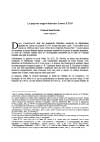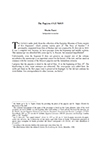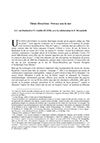hiûˋratique
« Le papyrus magico-funûˋraire Louvre E 5353 »
ENiM 6, 2013, p. 257-289.
 Publication du pLouvre E 5353, dãûˋpoque romaine et de provenance inconnue, rûˋdigûˋ au profit dãune certaine Ḥr-ʿnḫ. Le papyrus dont le dûˋbut manque est aujourdãhui constituûˋ de quatre pages dont la derniû´re est restûˋe vierge de toute inscription ou dessin. On lit sur les deux premiû´res un assez long texte rûˋdigûˋ en hiûˋratique, prûˋcûˋdûˋ de quelques vignettes empruntûˋes au Livre des Morts. Introduit par le titre du ch. 125 et quelques sûˋquences originales dont un emprunt au ô¨ grand dûˋcret ûˋmis pour la province-igeret ô£, ce texte, oû¿ interviennent plusieurs officiants, expose un rituel dãexûˋcration contre Apophis qui se poursuit avec des extraits du ch. 163 du Livre des Morts et de la scû´ne 72 B du rituel de lãouverture de la bouche. Divers indices rûˋpartis dans lãensemble du papyrus invitent û penser que les opûˋrations magiques ici dûˋcrites, bien quãinattendues dans ce contexte funûˋraire, ûˋtaient rûˋalisûˋes dans les derniers jours de Khoiak et concouraient comme le reste du texte û la renaissance de la dûˋfunte û lãinstar dãOsiris.
Publication du pLouvre E 5353, dãûˋpoque romaine et de provenance inconnue, rûˋdigûˋ au profit dãune certaine Ḥr-ʿnḫ. Le papyrus dont le dûˋbut manque est aujourdãhui constituûˋ de quatre pages dont la derniû´re est restûˋe vierge de toute inscription ou dessin. On lit sur les deux premiû´res un assez long texte rûˋdigûˋ en hiûˋratique, prûˋcûˋdûˋ de quelques vignettes empruntûˋes au Livre des Morts. Introduit par le titre du ch. 125 et quelques sûˋquences originales dont un emprunt au ô¨ grand dûˋcret ûˋmis pour la province-igeret ô£, ce texte, oû¿ interviennent plusieurs officiants, expose un rituel dãexûˋcration contre Apophis qui se poursuit avec des extraits du ch. 163 du Livre des Morts et de la scû´ne 72 B du rituel de lãouverture de la bouche. Divers indices rûˋpartis dans lãensemble du papyrus invitent û penser que les opûˋrations magiques ici dûˋcrites, bien quãinattendues dans ce contexte funûˋraire, ûˋtaient rûˋalisûˋes dans les derniers jours de Khoiak et concouraient comme le reste du texte û la renaissance de la dûˋfunte û lãinstar dãOsiris.
 Publication of pLouvre E 5353, of Roman Period and of unknown provenance, written for the benefit of a woman named Ḥr-ʿnḫ. The text, whose beginning is missing, nowadays consists of four pages, the last one left free from any inscription or drawing. On the two first pages, one can read a text, rather long and written in hieratic, preceded by a few illustrations from the Book of the Dead. Introduced by the ch. 125 and some original sequences, among which a short borrowing from the ãgreat decree issued for the nome of igeretã, this text, in which several officiants play a part, includes an execration ritual against Apophis, and goes on with excerpts of ch. 163 of the Book of the Dead, and of (the) scene 72b of the Ritual of opening the mouth. Several clues here and there in the papyrus suggest that the magical rites here described, though unexpected in such a funerary context, were performed during the last days of Khoiak, and contributed, together with the rest of the text, to the deceasedãs rebirth like Osiris.
Publication of pLouvre E 5353, of Roman Period and of unknown provenance, written for the benefit of a woman named Ḥr-ʿnḫ. The text, whose beginning is missing, nowadays consists of four pages, the last one left free from any inscription or drawing. On the two first pages, one can read a text, rather long and written in hieratic, preceded by a few illustrations from the Book of the Dead. Introduced by the ch. 125 and some original sequences, among which a short borrowing from the ãgreat decree issued for the nome of igeretã, this text, in which several officiants play a part, includes an execration ritual against Apophis, and goes on with excerpts of ch. 163 of the Book of the Dead, and of (the) scene 72b of the Ritual of opening the mouth. Several clues here and there in the papyrus suggest that the magical rites here described, though unexpected in such a funerary context, were performed during the last days of Khoiak, and contributed, together with the rest of the text, to the deceasedãs rebirth like Osiris.
 Consulter cet article (40833) -
Consulter cet article (40833) -  Télécharger cet article au format pdf (21524)
Télécharger cet article au format pdf (21524)
« The Papyrus CGT 54015 »
ENiM 15, 2022, p. 117-121.
 Lãarticle est consacrûˋ û un papyrus du musûˋe ûˋgyptologique de Turin datûˋ du Nouvel Empire. Il contient cinq fragments du bien connu ô¨ Conte de Sanehet (Sinouhûˋ) ô£. Dans de nombreux cas, cette version correspond aux sources de cette pûˋriode avec quelques variations. Une transcription hiûˋroglyphique accompagnûˋe dãune traduction commentûˋe et dãune photographie sont ici prûˋsentûˋes.
Lãarticle est consacrûˋ û un papyrus du musûˋe ûˋgyptologique de Turin datûˋ du Nouvel Empire. Il contient cinq fragments du bien connu ô¨ Conte de Sanehet (Sinouhûˋ) ô£. Dans de nombreux cas, cette version correspond aux sources de cette pûˋriode avec quelques variations. Une transcription hiûˋroglyphique accompagnûˋe dãune traduction commentûˋe et dãune photographie sont ici prûˋsentûˋes.
 The paper deals with a papyrus from the collection of the Egyptian Museum in Turin dated to the NK. It contains five fragments from the well-known ãStory of Sanehet (Sinuhe)ã. In many cases this version corresponds to the sources from this period with some variations. A hieroglyphic transcription, a commented translation, and a photography are presented.
The paper deals with a papyrus from the collection of the Egyptian Museum in Turin dated to the NK. It contains five fragments from the well-known ãStory of Sanehet (Sinuhe)ã. In many cases this version corresponds to the sources from this period with some variations. A hieroglyphic transcription, a commented translation, and a photography are presented.
 Consulter cet article (32331) -
Consulter cet article (32331) -  Télécharger cet article au format pdf (11267)
Télécharger cet article au format pdf (11267)
« ThûÇnis-Hûˋraclûˋion : Ostraca sous la mer »
ENiM 15, 2022, p. 321-334.
 Deux ostraca inscrits encore lisibles aprû´s plus de 2000 ans dãimmersion dans lãocûˋan ont ûˋtûˋ mis au jour sur le site immergûˋ de ThûÇnis-Hûˋraclûˋion dans un contexte archûˋologique fin cinquiû´me siû´cle/dûˋbut quatriû´me av. J.-C. Lãun, en dûˋmotique, malheureusement incomplet, est une lettre de type ô¨ requûˆte ô£, lãautre, en hiûˋratique, employant un hiûˋroglyphe archaû₤que, montre un groupe de signes en rapport, semble-t-il, avec le repas royal. Les deux fragments ont ûˋtûˋ relevûˋs û environ 13 mû´tres de distance lãun de lãautre sur une ûÛle couverte dãoffrandes situûˋe û lãentrûˋe de la bouche Canopique.
Deux ostraca inscrits encore lisibles aprû´s plus de 2000 ans dãimmersion dans lãocûˋan ont ûˋtûˋ mis au jour sur le site immergûˋ de ThûÇnis-Hûˋraclûˋion dans un contexte archûˋologique fin cinquiû´me siû´cle/dûˋbut quatriû´me av. J.-C. Lãun, en dûˋmotique, malheureusement incomplet, est une lettre de type ô¨ requûˆte ô£, lãautre, en hiûˋratique, employant un hiûˋroglyphe archaû₤que, montre un groupe de signes en rapport, semble-t-il, avec le repas royal. Les deux fragments ont ûˋtûˋ relevûˋs û environ 13 mû´tres de distance lãun de lãautre sur une ûÛle couverte dãoffrandes situûˋe û lãentrûˋe de la bouche Canopique.
 Two inscribed ostraca still readable after 2000 years of immersion in the ocean were brought to light on the underwater site of ThûÇnis-Hûˋracleion in an archaeological context end of fifth/early fourth century B.C. The unfortunately incomplete one in demotic script is a letter of the type ô¨ request ô£, the other in hieratic script using an archaic hieroglyph displays a group of signs apparently related to the royal repast. Both fragments were discovered at a distance of approximately 13 metres from each other on an island covered with offerings, located at the entrance of the Canopic mouth of the Nile.
Two inscribed ostraca still readable after 2000 years of immersion in the ocean were brought to light on the underwater site of ThûÇnis-Hûˋracleion in an archaeological context end of fifth/early fourth century B.C. The unfortunately incomplete one in demotic script is a letter of the type ô¨ request ô£, the other in hieratic script using an archaic hieroglyph displays a group of signs apparently related to the royal repast. Both fragments were discovered at a distance of approximately 13 metres from each other on an island covered with offerings, located at the entrance of the Canopic mouth of the Nile.
 Consulter cet article (22103) -
Consulter cet article (22103) -  Télécharger cet article au format pdf (9511)
Télécharger cet article au format pdf (9511)
ENiM 18 - 2025
4 article(s) - 11 mars 2025.
ENiM 1 à 18 (2008-2025) : 223 articles
4 023 057 téléchargements
8 341 990 consulations.
Index des auteurs

Mots clés

Derniers articles : 
Robert Steven Bianchi
Duplication and Continuity
(ENiM 18, p. 13-36 — 11 mars 2025) 
Frûˋdûˋric Mougenot
Rûˋnûˋnoutet û la porte de la maison
(ENiM 18, p. 1-12 — 29 janvier 2025) 
CENiM - Mise en ligne des volumes ûˋpuisûˋs : 
 Anne-Sophie von BOMHARD Dûˋcans ûˋgyptiens, CENiM 23, Montpellier, 2020 — (2020)
Anne-Sophie von BOMHARD Dûˋcans ûˋgyptiens, CENiM 23, Montpellier, 2020 — (2020) 
 Jean-Claude Grenier L'Osiris ANTINOOS, CENiM 1, Montpellier, 2008 — (26 dûˋcembre 2008)
Jean-Claude Grenier L'Osiris ANTINOOS, CENiM 1, Montpellier, 2008 — (26 dûˋcembre 2008) 
TDENiM - Mise en ligne des volumes ûˋpuisûˋs : 
 Twitter
Twitter 3617338 visites - 10991 visite(s) aujourd’hui - 69 connecté(s)
© ENiM - Une revue d’égyptologie sur internet
Équipe Égypte Nilotique et Méditerranéenne - UMR 5140 - « Archéologie des Sociétés Méditerranéennes » (Cnrs) - Université Paul Valéry - Montpellier III
























 Contact
Contact
 Abonnez-vous !
Abonnez-vous ! Équipe Égypte Nilotique et Méditerranéenne
Équipe Égypte Nilotique et Méditerranéenne UMR 5140 « Archéologie des Sociétés Méditerranéennes » (Cnrs)
UMR 5140 « Archéologie des Sociétés Méditerranéennes » (Cnrs) Université Paul Valéry - Montpellier III
Université Paul Valéry - Montpellier III